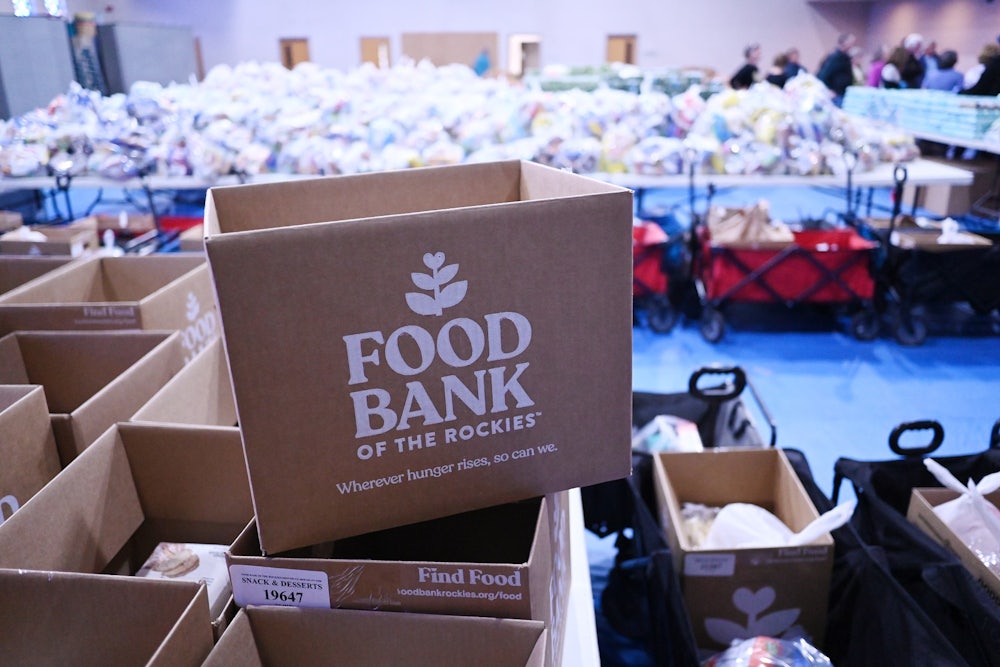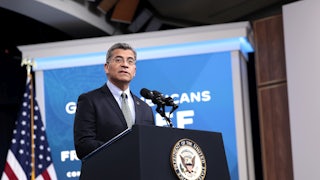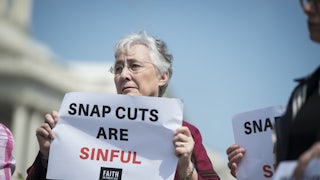In March 2020, the Minnesota food bank Second Harvest Heartland moved its headquarters to a new location, a massive warehouse three times the size of its previous facilities. At 233,000 square feet, the warehouse is large enough to house four football fields.
The timing was fortuitous: March 2020 also saw the onset of the coronavirus pandemic in the United States, with lockdown restrictions and job losses exacerbating food insecurity for low-income Americans. “We tripled in size just at the right time,” said Allison O’Toole, the CEO of Second Harvest Heartland. The food bank, which works with hundreds of agencies and programs to distribute food assistance across a 59-county area in Minnesota and western Wisconsin, has seen a 30 percent increase in distributions.
In response to the unprecedented crisis of the pandemic, Congress took dramatic action to assist struggling Americans, including implementing emergency allotments for the Supplemental Nutrition Assistance Program, or SNAP, more commonly known as food stamps. These temporary benefits, aimed at addressing food insecurity, helped cushion the economic blow for low-income households. But the end of the emergency allotments means that millions of SNAP beneficiaries are facing a “hunger cliff” this month—a dramatic decrease in their benefits, arriving in concert with high inflation and elevated grocery costs.
“We know this will create hardship for many people—especially seniors, families with children, and people with disabilities—who will then turn to the charitable food system for support,” said Vince Hall, the chief government relations officer at Feeding America, a national network of food banks. “Feeding America network food banks are doing all they can to prepare for longer lines at food distributions, but food banks are already under immense strain.”
As pandemic-related relief measures expire, the families that were kept afloat by the temporary assistance are losing that parachute. Brian Greene, the president and CEO of the Houston Food Bank, told me that the SNAP emergency allotments and the expanded child tax credit had the greatest impact of the pandemic relief measures. The expiration of the child tax credit at the end of 2021 resulted in an increase in demand for services provided by the food bank in 2022, a pattern that Greene expects to repeat with the end of the SNAP emergency allotments. “We do expect this to be a significant detriment to Texas, and over 300,000 families will have a significant decrease,” Greene said.
The emergency allotments were tied to the public health emergency regarding the coronavirus, and more than a dozen states chose to opt out of issuing the additional benefits at various points during the pandemic: 10 states ended the emergency allotments in 2021, joined by seven more states in 2022 and one in January of this year. But the government funding bill passed by Congress in December ended the emergency allotments for the 32 states, the District of Columbia, Guam, and the U.S. Virgin Islands, which were still issuing the additional benefits, extending the program only through February.
A January report by the Institute for Policy Research at Northwestern University found that emergency allotment payments reduced the likelihood that a household experienced food insufficiency by 9 percent. The expiration of the allotments affects the roughly 16 million households that will now receive at least $95 less per month in benefits, according to the Center for Budget and Policy Priorities, a left-leaning think tank. The average person will receive around $90 less in monthly benefits. But for SNAP recipients receiving the minimum benefit—often elderly Americans living on a fixed income—that decrease could be a precipitous drop from $281 to $23 in monthly benefits. The average SNAP benefit will amount to around $6 per day.
Minnesota and Texas are among the states that will be most affected by the decrease; Minnesota will see a $208 decrease in monthly benefits per household, and Texas will have a $189 reduction per household. O’Toole said that Second Harvest was hearing stories from partners about double or triple the volume in visits with the end of the emergency allotments.
States losing their emergency allotments this month can look to the experiences of states that stopped issuing them last year or in 2021. “There are some other states who have rolled this back a little earlier, and so we understood from many of them that, yes, there was a bump up. It did vary from state to state and location to location, but there was definitely an increase in need,” said Radha Muthiah, the CEO of the Capital Area Food Bank, which services the Washington, D.C., metropolitan region.
One such state is Iowa, which ended its emergency allotments in March 2022. Luke Elzinga, the chair of the Iowa Hunger Coalition and policy and advocacy manager at a network of Des Moines–area food pantries, said that food pantries had seen an increase in need after the end of the emergency allotments. That demand has not significantly decreased; Elzinga said it was less of a “spike” and more of a “backwards cliff.”
“In terms of what folks can expect in other states, I hate to be the bearer of bad news, but I think we’re really going to see millions of Americans turning to food pantries to help them feed their families,” Elzinga predicted. In the Des Moines area, there has been an increase in first-time users of food banks, Elzinga said, as well as people returning to food pantries for the first time since the beginning of the pandemic; they had previously been stabilized by the now-expired emergency measures.
The increase in demand spurred by the end of emergency allotments could put further stress on food banks and their partners, which have already been overwhelmed by increased costs, supply chain issues, and insufficient volunteer help throughout the pandemic. “Because donations haven’t gotten back to the same level [as pre-pandemic], and we’ve had some supply chain challenges, despite the best attempts of USDA to ensure more food coming through to us, we’ve had to purchase more,” Muthiah said. Those factors, along with increased food costs and still elevated demand, has contributed to an increase in the Capital Area Food Bank’s spending to purchase food from $5 million to $24 million in the wake of the pandemic.
While charity organizations play a critical role in serving people struggling with food insecurity, they do not have the funds or the resources to replace nutrition assistance programs. SNAP delivers roughly nine times more food than the entire Feeding America network, which includes Second Harvest Heartland, the Capital Area Food Bank, and the Houston Food Bank.
“I think there’s a misunderstanding of just how much we can do,” said Greene, the CEO of the Houston Food Bank. “When you have a very significant cut in SNAP and you think that, ‘oh, the charitable system will pick up the slack,’ it’s certainly not true.”
The end of emergency allotments comes as Congress is beginning to negotiate the massive legislation known as the farm bill, which includes a nutrition title covering food programs like SNAP. Anti-hunger advocates hope that Congress finds some way to strengthen the program in the next farm bill, such as by expanding SNAP eligibility, streamlining the application process for nutrition assistance programs, and changing the formula by which SNAP benefits are determined.
“Anytime there’s a change to SNAP—SNAP gets cut, or there’s additional administrative hurdles put in place—we see more people. If you give people more SNAP benefits, if you make it more accessible, we see less people at food pantries,” Elzinga said. “We want to put ourselves out of a job. And part of that is engaging in policy advocacy, because we realize that SNAP is the best tool that we have in our tool belt in the fight against hunger.”
But the Republican-controlled House is unlikely to agree to any such proposal, nor are the GOP senators needed to avert a filibuster in the upper chamber. Senator John Boozman, the ranking member of the Senate Agriculture Committee, argued in a hearing last month that a 2021 increase in SNAP benefits by the USDA was improperly administered without congressional oversight. Some House Republicans have also floated cuts to SNAP as a means to reducing the deficit, as well as implementing more work requirements.
With the emergency allotments coming to an end across the country and the future of SNAP uncertain, food assistance charities nonetheless see an opportunity for improving the system. “I want to be able to stop telling you that the need keeps going up. I want to be able to stop saying that,” O’Toole said. “And the way we do that is through not only us doing our work, but shared and sustained solutions, especially at the government level.”






